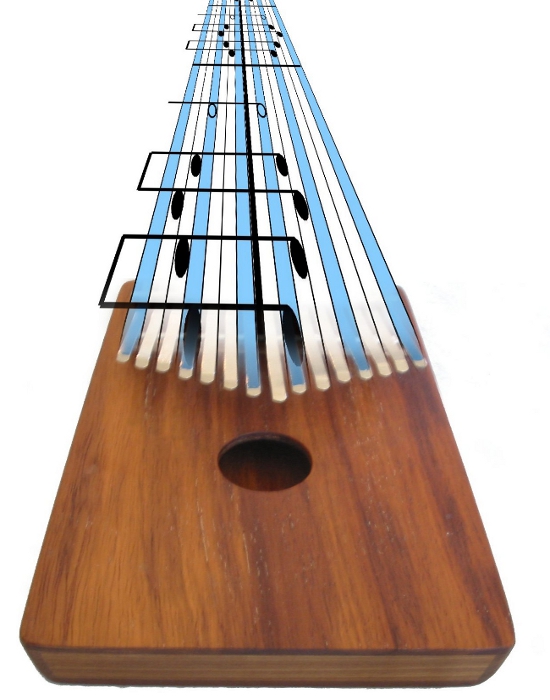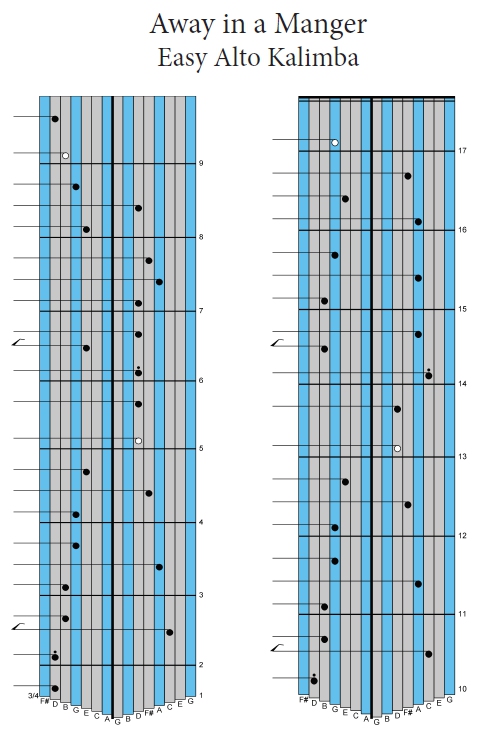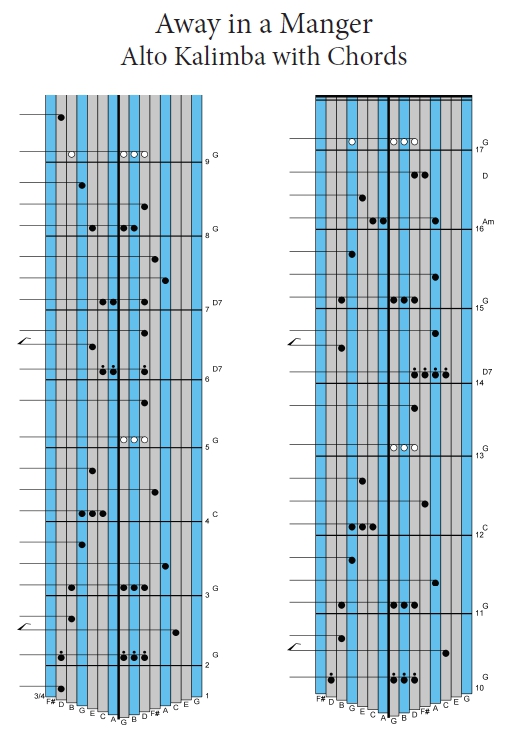
Use of this website constitutes acceptance of the Privacy Policy and User Agreement. Copyright © 2020 Kalimba Magic. All Rights Reserved.
Often people think of the kalimba as a very simple instrument. However, it stands proudly with the harp, the guitar, and the keyboard as instruments that can play both a melody and musical accompaniment – in other words, you can play complex music with the kalimba.
I’d like to show you a few rules of thumb that are very useful in creating a more interesting and profound-sounding song, starting with an easy, familiar melody. It will help you know where, when and how to create simple chordal accompaniment which can very easily make your kalimba playing absolutely gorgeous.
The music you hear when you load the page, or when you start the media player near the bottom of this page, is, of course, “Away in a Manger,” the classic Christmas carol.
Christmas carols are the perfect place to start learning to read kalimba tablature, because you already know how the music sounds. You can probably sing a number of carols without thinking. This knowledge really helps a lot when you are first exploring how to read kalimba tablature which shows you notes, timing, and chords.
Look at the tablature as a map of the kalimba tines. If you can follow a road map, then you can follow a kalimba map, and consequently it should be pretty simple to make nice sounds on the instrument. If tablature is new to you, please do spend a little time on the Kalimba Magic page “How to Read and Write Kalimba Tablature.” There is a link in the list of Related Articles at the bottom of this post.
The best kalimbas for playing Christmas carols are the Alto, Treble, or Bb Treble. The recording and the tablature below are meant for the Alto kalimba, but the Bb Treble reads Alto tablature also. The standard Treble needs its own separate tablature.

The tablature, or tab, is a map of the kalimba and shows you which tines to play. Each type of kalimba has its own distinct tine pattern and thus a unique tablature. The tablature shown here is for the Alto kalimba.
Below is an elementary version of “Away in a Manger” for the Alto kalimba in tablature. Pick up your kalimba and give it a try. Repeat the simple melody until it is pretty much second nature to you.

An elementary version of “Away in a Manger” for the Alto kalimba. Click to download free Alto tablature PDF.
Once you understand the melody and can play it fairly consistently, you can really add a lot of musicality to your playing by adding chords to the melody note in the first beat of each measure.

The same melody – “Away in a Manger,” plus chords, usually played on the first beat of each measure. Click to download free Alto tablature PDF.
If you don’t know about chords, just look at the shape of the G chord in measure two (left column, almost at the bottom) – the three notes on the right side. The shape of this group of notes, or chord, and the physical action you need to make to accomplish that chord, are all you need to know about it at first. To play this three-note chord, or triad, you probably need to do a glissando, where you drag your thumb nail (or use an Alaska Pik, a temporary nail extender; see the link at bottom of this post) across the played tines, from low to high, meaning from the center outward.
Here are those rules of thumb for chords on the Alto, Treble, Bb Treble, or D Treble kalimbas:
First, assume that you can get away with just playing chords on the first beat of each measure. In the tab above, there is a chord in the first beat of every measure, and there is only one chord in this entire tab that is not on the first beat of its measure (the last beat in measure 16, a two-note chord).
Next, a rule of thumb for knowing which notes to play in the chords: consider the melody note at the start of the measure, and play two or three notes in a chord on the opposite side of your melody note, and also lower on the kalimba. Following this simple rule will get you more than half the chords in a song.
Also: if the opposite-side chord doesn’t sound good, try one, two, or even three notes on the same side as the melody note, but pitched lower (more central on the kalimba) than the melody note. You can play the chordal notes and the melody note with a single glissando. This can be seen at measures 4 and 5.
And last: if it sounds good, it is good. If a chord doesn’t sound good to you, first see if you can isolate exactly what sounds bad – does the left or the right thumb need to change what it’s playing? Don’t be afraid to change the note or notes that don’t sound right, until things sound good. And then they are good.


Sign up for our newsletter and free resources with your email address:
We pinky promise not to spam you and to only send good stuff.
 Assist Paul Tracey Rebuild His House in Pacific Palisades
Assist Paul Tracey Rebuild His House in Pacific Palisades 8-Note Spiral Kalimba Turned into a Student Karimba
8-Note Spiral Kalimba Turned into a Student Karimba Seek to Infuse Your Musical Moments With Beauty and Magic
Seek to Infuse Your Musical Moments With Beauty and MagicUse of this website constitutes acceptance of the Privacy Policy and User Agreement. Copyright © 2020 Kalimba Magic. All Rights Reserved.